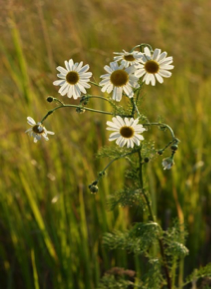Essential oil of German Chamomile, Matricaria recutita
Family: Asteraceae
Origin: Germany, England, Hungary, France, (all over Europe) Egypt, South America, North America, Asia, India
Plant Description: An annual herb, Matricaria recutita has a branched, erect and smooth stem with daisy white flowers. Plants grow to a height of 6 to 24 inches. Blooms in early to midsummer and has a strong scent.
Part of the plant used: flower heads
Extraction method: Solvent extraction, CO2 Extraction and steam distillation
Main Chemical Constituents: The main constituents of German chamomile oil are chamazulene, a-bisabolol, farnesene, bisabolol oxide A, bisabolol oxide B and bisabolone oxide A. Chemotypes vary depending on plants growing environment. If collected in the morning the EO retrieved will be high in farnesene and bisabolol but only traces are found if the plant is collected in the evening.
Precautions: There may be sensitivity if person has a ragweed allergy. Contains coumarin so care should be taken if using blood thinners.
Properties: antibacterial, antifungal, antiseptic and antiviral, anti-inflammatory, anti-allergenic, nervine, antidepressant, vulnerary, immunostimulant, relaxant, analgesic, antispasmodic, emmenagogue, cephalic, digestive, stomachic, antiphlogistic, cicatrisant
Uses:
Mental/Emotional: Calming, relieves nervousness, insomnia, anger, depression, frustration, emotional tension, stress, irritability, sensitivity, moodiness, resentment, temper.
Skin: beneficial for dry and sensitive skin, calming, acne, eczema, psoriasis, dermatitis, burns, healing of wounds, scars and skin conditions.
Muscular/joint: inflammation, rheumatism, arthritis
Circulation: vascular complaints, hypertension, hypotension, poor circulation, varicose veins
Digestive: upset stomach, nausea, parasites, irritable bowel, mild laxative, constipation, diarrhea, mucositis
Menstrual/reproductive: pms, menstrual pain, cramping, endometriosis, menopause, absent or scanty menstruation, heavy menstruation, vaginal irritations.
Organs: helps to regenerate the liver.
Its medicinal usage dates back to antiquity where such notables as Hippocrates, Galen, and Asclepius made written reference to it. The deep blue color of German Chamomile oil is due to the content of azulene (chamazulene). Acid value of the German oil is higher than the Roman oil so more azulene forms. Certain chemotypes produce more or less amounts of alpha-bisabolol, chamazulene and farnesene and these various amounts determine what the specific chemotype will be used for. Jeanne Rose classifies chamomile as one of the five most important oils along with Eucalyptus, Lavender, Myrrh and Rose.
For more information about massage or aromatherapy or to create your own unique therapeutic blend, please contact Laura Jarrell at laura@jacksonvillespa.com, call 541-621-5791 or visit the Spa Jacksonville website: http://www.jacksonvillespa.com/.
